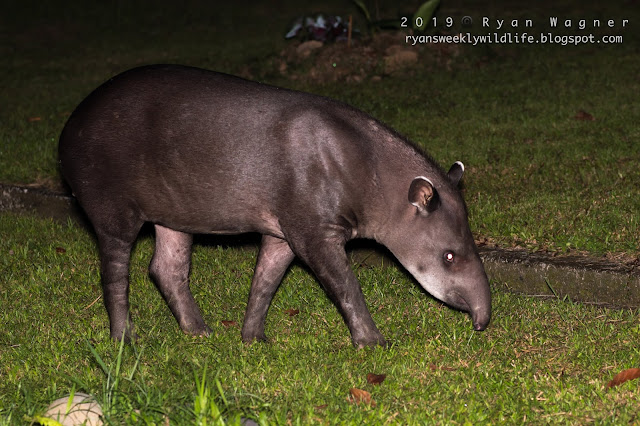By the evening of our third night at Yasuni, we were all exhausted from a day of hiking through the sweltering jungle, identifying plants, and getting stung and bittern by insects. I had finished my soup and just started into my rice (two staples of our stay in Ecuador) when our TA, Anne, burst through the doors. “The tapirs are here!” she exclaimed. I dropped my silverware next to my unfinished meal and joined my classmates in a mad dash for the door.
Full darkness had set in as we ate, but silhouetted against the gloomy, moth-swarmed porch lights, loomed a hulking, hair-covered shape. The creature’s gray body swayed slightly as it lowered a massive head and neck to single-mindedly feed on a pile of overripe bananas. It payed us no mind as a dozen exuberant plant biologists swarmed the railings near where the animal fed. This was a lowland tapir (Tapirus terrestris). The animal was easily two or three times my size, with a pudgy, though clearly muscular, frame. Its beady eyes gleamed in our flashlights as its bizarre, trunk-like snout contorted too scoop up entire bunches of bananas. A thick, mohawk of hair stretched from the tapir’s forehead down to its shoulders—giving it an appearance more like that of a wild stallion (its closest relative) than a pig or boar.
Full darkness had set in as we ate, but silhouetted against the gloomy, moth-swarmed porch lights, loomed a hulking, hair-covered shape. The creature’s gray body swayed slightly as it lowered a massive head and neck to single-mindedly feed on a pile of overripe bananas. It payed us no mind as a dozen exuberant plant biologists swarmed the railings near where the animal fed. This was a lowland tapir (Tapirus terrestris). The animal was easily two or three times my size, with a pudgy, though clearly muscular, frame. Its beady eyes gleamed in our flashlights as its bizarre, trunk-like snout contorted too scoop up entire bunches of bananas. A thick, mohawk of hair stretched from the tapir’s forehead down to its shoulders—giving it an appearance more like that of a wild stallion (its closest relative) than a pig or boar.
A high pitched whistle sounded from behind me. We all wheeled around to see a miniaturized version of the tapir, trunk and all, pacing nervously by the edge of the clearing. This mother had brought along her young calf. The baby remained skittish and distrusting of our attention, often squealing for her mother as she galloped towards the safety of the jungle. The mother tapir ignored her babies cries of discomfort just as she did our collective gaze. Tapirs are solitary animals, coming together only to breed. In just a year, the baby will be on its own.
Tame as the mother might have appeared, she was very much a wild amazonian. The workers at the station had warned us not to run out of bananas; a hungry tapir will protest with a bite to the thigh or buttock. Being a vegetarian, the tapir's mouth is full of grinding, crushing teeth—not something I wanted to be on the receiving end of.
The pair’s trips to the research station were mysterious and unpredictable; the next day the mother and her calf would disappear back into the jungle, leaving behind no sign of their nocturnal visit except a few less bananas. We wouldn't see them again until the morning of our departure from Yasuni, “to say goodbye,” we told each other with a wink.
An encounter with the tapir surpassed my wildest dreams, but the mother’s habituation to people left a sour taste in my mouth. If these tapirs already find it easier to scrounge human scraps rather than to find food in their natural habitat, what will illegal hunting, climate change, and increased deforestation mean for this single mother and those like her? The IUCN Redlist ranks the lowland tapir as vulnerable. I can only hope our impacts will not lead to the extinction of these remarkable rainforest mammals.
An encounter with the tapir surpassed my wildest dreams, but the mother’s habituation to people left a sour taste in my mouth. If these tapirs already find it easier to scrounge human scraps rather than to find food in their natural habitat, what will illegal hunting, climate change, and increased deforestation mean for this single mother and those like her? The IUCN Redlist ranks the lowland tapir as vulnerable. I can only hope our impacts will not lead to the extinction of these remarkable rainforest mammals.









No comments:
Post a Comment